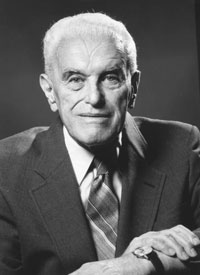John Harsanyi facts for kids
Quick facts for kids
John Harsanyi
|
|
|---|---|
 |
|
| Born |
Harsányi János Károly
May 29, 1920 Budapest, Hungary
|
| Died | August 9, 2000 (aged 80) Berkeley, California, USA
|
| Nationality | United States |
| Alma mater | University of Lyon University of Budapest University of Sydney Stanford University |
| Known for | Bayesian games Utilitarian ethics Equilibrium selection |
| Spouse(s) | Anne Klauber |
| Awards | Nobel Memorial Prize in Economic Sciences (1994) First prize in Eötvös mathematics competition |
| Scientific career | |
| Fields | Economics |
| Institutions | University of California, Berkeley Wayne State University Australian National University University of Queensland |
| Doctoral advisor | Kenneth Arrow |
| Influenced | Kenneth Binmore |
John Charles Harsanyi (Hungarian: Harsányi János Károly; May 29, 1920 – August 9, 2000) was a smart Hungarian-American economist. He won the Nobel Memorial Prize in Economic Sciences.
He is famous for his work on game theory. This is a way to study how people make decisions when their choices affect others. He especially looked at "games of incomplete information," which are now called Bayesian games. This means situations where players don't know everything about each other. John Harsanyi also used game theory to think about ethics and how to choose the best outcomes in games.
In 1994, he shared the Nobel Prize with John Nash and Reinhard Selten.
Contents
Early Life and Education in Hungary
John Harsanyi was born in Budapest, Hungary, on May 29, 1920. His father owned a pharmacy. John went to the Lutheran Gymnasium, a high school in Budapest. He was very good at math and physics. He even won first prize in a math competition for high school students.
John wanted to study math and philosophy. But his father wanted him to study chemical engineering. So, in 1939, he went to France for a short time. Because World War II started, he returned to Hungary. He then studied pharmacology at the Eötvös Loránd University in Budapest. He earned his diploma in 1944.
During the war, John faced many challenges. He was forced to join a labor unit. Later, he managed to escape and found safety in a Jesuit house. He stayed there until the war ended.
Life After the War
After World War II, John Harsanyi went back to the University of Budapest. He studied philosophy and sociology. He earned his Ph.D. in both subjects in 1947. He also studied theology.
He worked at the Institute of Sociology at the University of Budapest. There, he met Anne Klauber, who would become his wife. John had strong opinions against the government's ideas at the time. Because of this, he had to leave his job. Anne also faced pressure to leave him.
In 1950, John, Anne, and her parents left Hungary. They crossed the border into Austria illegally. From there, they went to Australia.
Starting Fresh in Australia
John and Anne got married in Australia on January 2, 1951. They didn't speak much English at first. John's degrees from Hungary were not recognized in Australia.
He worked in a factory during the day. In the evenings, he studied economics at the University of Sydney. He earned a master's degree in 1953. While studying, he started writing research papers for economic journals.
In 1954, he became a teacher at the University of Queensland in Brisbane. Anne became a fashion designer there.
Moving to the United States
In 1956, John received a special scholarship. This allowed him and Anne to go to the United States. They spent two years at Stanford University. At Stanford, John wrote his second Ph.D. paper. It was about game theory, and his advisor was Kenneth Arrow. He earned his second Ph.D. in economics in 1959.
After his student visa expired, they returned to Australia. John worked at the Australian National University. But he found that not many people in Australia were interested in game theory.
With help from friends, he moved back to the United States. From 1961 to 1963, he was a professor at Wayne State University in Detroit. In 1964, he moved to Berkeley. He stayed at the University of California, Berkeley, until he retired in 1990. Soon after moving to Berkeley, John and Anne had a son named Tom.
Nobel Prize Work
While at Berkeley, John Harsanyi did a lot of important research in game theory. He published a series of articles in 1967 and 1968. This work created a way to understand "games of incomplete information." These are situations where players have different information about the game.
He figured out how players could make smart choices even when they didn't know everything. He imagined that "Nature" makes some initial choices using probabilities. Some players see Nature's choice, while others only know the probabilities. This idea is called the "Harsanyi Doctrine." It assumes all players understand the game's structure and the probabilities involved.
From 1966 to 1968, John Harsanyi was part of a team. They advised the United States Arms Control and Disarmament Agency. They used game theory to help with important decisions.
John Harsanyi passed away on August 9, 2000, in Berkeley, California. He was 80 years old.
See also
 In Spanish: John Harsanyi para niños
In Spanish: John Harsanyi para niños
Images for kids


